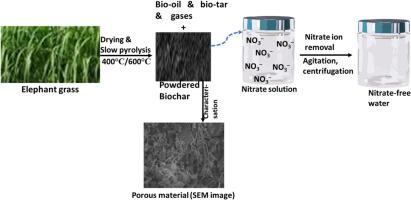Journal of Environmental Chemical Engineering ( IF 7.4 ) Pub Date : 2020-09-22 , DOI: 10.1016/j.jece.2020.104507 Florence Mibinuola Adesemuyi , Matthew Ayorinde Adebayo , Adebisi Olayinka Akinola , Emmanuel Folorunso Olasehinde , Kehinde Abiodun Adewole , Labunmi Lajide

|
Biochar is a solid material obtainable from biomass pyrolysis and useful for pollution alleviation and soil amendment. In this study, Biochars A and B were produced from elephant grass at pyrolytic temperatures of 400 °C and 600 °C, respectively, for removal of nitrate ion from aqueous solution. The physicochemical characteristics of the biochars were evaluated. The biochars were also characterised using Fourier Transform Infrared (FTIR) spectroscopy, Scanning Electron Microscopy (SEM), Energy Dispersive X-ray (EDX), and X-ray Diffraction (XRD). Operational variables such as pH, contact time, and concentration of nitrate ion were varied and optimum variables were obtained. Kinetic and equilibrium data were subjected to kinetic (pseudo-first order, pseudo-second order, Avrami fractional order, Elovich and intraparticle diffusion) and equilibrium (Langmuir, Freundlich, Liu, and Redlich-Peterson) models, respectively, to elucidate the interaction between the nitrate ion and biochars. The yields of Biochars A and B were 41.40 % and 32.25 %, respectively. The two biochars possessed good cation exchange capacity, water-holding capacity, carbon stability, and porosity. Avrami fractional kinetic order was the best model that explained the kinetic data. Maximum adsorption capacities obtained from Liu model (the best equilibrium model) are 140.7 and 237.5 mg g−1 for Biochars A and B, respectively. Adsorption process was spontaneous and exothermic. There was a decrease in the disorderliness in the nitrate-biochar system. Biochar B performed better than Biochar A for removal of nitrate ion from water. In summary, the biochars produced from elephant grass excellently removed nitrate ion from solution and could be utilised for water decontamination.
中文翻译:

象草生物炭的制备,表征及其在硝酸盐去除中的应用:热解温度的影响
生物炭是可通过生物质热解获得的固体材料,可用于减轻污染和土壤改良。在这项研究中,生物炭A和B分别从象草在400°C和600°C的热解温度下生产,用于从水溶液中去除硝酸根离子。评价了生物炭的理化特性。还使用傅立叶变换红外(FTIR)光谱,扫描电子显微镜(SEM),能量色散X射线(EDX)和X射线衍射(XRD)对生物炭进行了表征。改变诸如pH,接触时间和硝酸根离子浓度的操作变量,并获得最佳变量。对动力学和平衡数据进行动力学处理(伪一级,伪二级,Avrami分数级,Elovich和粒子内扩散)模型和平衡模型(Langmuir,Freundlich,Liu和Redlich-Peterson)分别用来阐明硝酸根离子和生物炭之间的相互作用。生物炭A和B的产率分别为41.40%和32.25%。这两种生物炭具有良好的阳离子交换能力,持水能力,碳稳定性和孔隙率。Avrami分数动力学顺序是解释动力学数据的最佳模型。从Liu模型(最佳平衡模型)获得的最大吸附容量为140.7和237.5 mg g 碳的稳定性和孔隙率。Avrami分数动力学顺序是解释动力学数据的最佳模型。从Liu模型(最佳平衡模型)获得的最大吸附容量为140.7和237.5 mg g 碳的稳定性和孔隙率。Avrami分数动力学顺序是解释动力学数据的最佳模型。从Liu模型(最佳平衡模型)获得的最大吸附容量为140.7和237.5 mg g-1对于生物炭A和B。吸附过程是自发的并且放热的。硝酸盐-生物炭系统的无序性有所降低。从水中去除硝酸根离子,生物炭B的性能优于生物炭A。总而言之,由象草生产的生物炭可以很好地去除溶液中的硝酸根离子,可用于水净化。










































 京公网安备 11010802027423号
京公网安备 11010802027423号